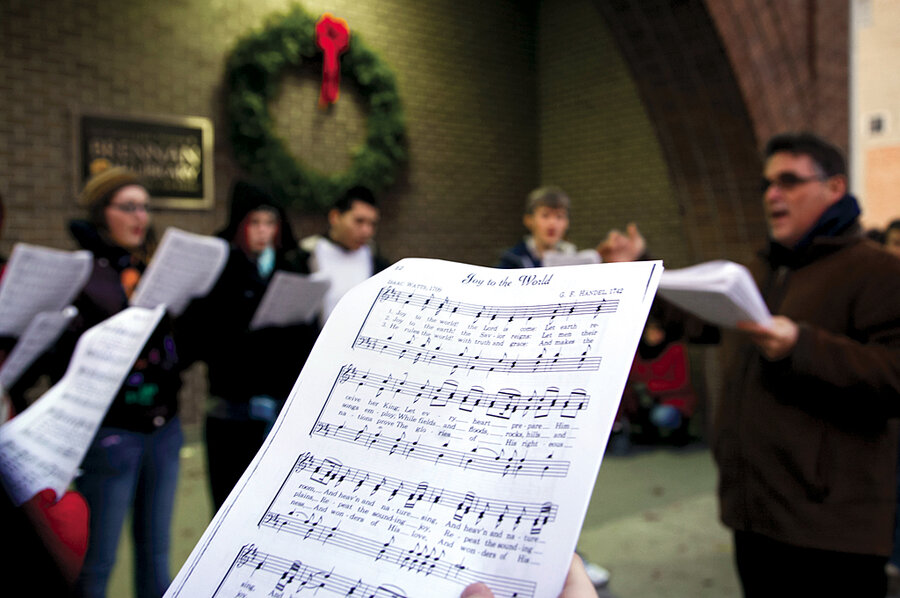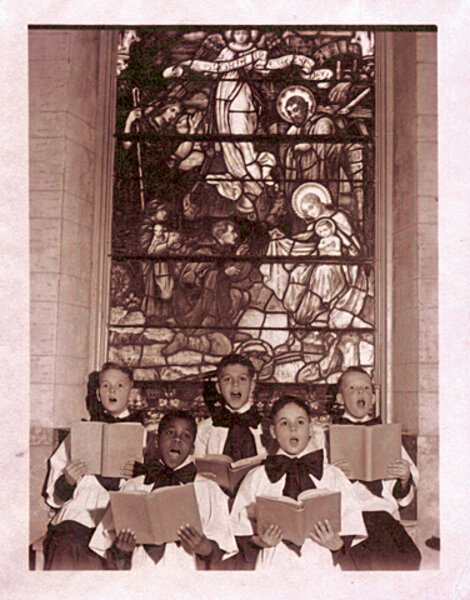Origins of America's favorite Christmas carols
Loading...
Armed with a notebook, a camera, a video camera, and an insatiable hunger to learn even more about some of America's most beloved Christmas carols, Ronald Clancy set out in October 2008 to visit their widely scattered places of origin.
Author of the 2006 "Best-Loved Christmas Carols: The Stories Behind Twenty-five Yuletide Favorites," Mr. Clancy has spent a lifetime tracking down their back stories. "When you get a sense of who the composer is...," he says, "it makes [the carol] so much more personal."
From his home state of New Jersey he traveled as far south as Georgia, westward to Pennsylvania and Michigan, and northeast to New York and Massachusetts.
Several weeks and some 4,000 miles later, after visiting numerous churches, graveyards, a town square, and crisscrossing Harvard University's campus in Cambridge, Mass., Clancy added greatly to his collection of fascinating facts about traditional Christmas songs. He found one with ties to a famous American poet, one with a connection to President Lincoln, and another inspired by the Cuban Missile Crisis.
Here are nine back stories from a series of videos he has begun to post on christmasclassics.com.
In the Deep South, of all places, Clancy visited a site tightly hitched to the legendary carol verse:
Dashing through the snow
In a one-horse open sleigh.
The composer of the carol, James Pierpont, was serving as an organist and music teacher at Savannah's Unitarian Church in Georgia, now known as the Jingle Bells Church, when in 1857 he copyrighted the song "One Horse Open Sleigh." But it's not clear when the New England-born Pierpont wrote the song. His hometown of Medford, Mass., also lays claim to the carol. What is clear, however, is that Pierpont made little money from the classic carol and died impoverished, despite the fact that he was the uncle of the wealthy financier J.P. Morgan. [Editor's note: The original misidentified the Jingle Bells church.]
Before visiting the Concord, Mass., grave of Katherine Davis, a Wellesley-educated music teacher, Clancy read the transcript of an interview in which Davis spoke about a tune she had running through her head "that practically wrote itself" in 1941 and that she titled "The Carol of the Drum." Eighteen years later, Davis was as surprised as the friend of hers who called to say:
"Kay, your carol is on the air, all the time, everywhere on radio!"
"What carol?" asked the surprised Davis.
"The Little Drummer Boy."
Davis's carol was becoming a hit, with a new title, some minor changes, and no mention of her as composer and lyricist. Able to prove authorship, she secured both credit and royalties, and, of course, a place in the pantheon of American Christmas carol creators.
Harvard University and the town of Cambridge are home to several carols. For example, the Rev. Edmund Hamilton Sears, a graduate of Harvard Divinity School, wrote the words to "It Came Upon the Midnight Clear."
John Sullivan Dwight, cofounder of the Harvard Musical Society, translated the 19th-century French carol, "Cantique de Noël," known in English as "O Holy Night." Harvard was also home to the famous poet Henry Wadsworth Longfellow, who taught there, and on Christmas Day 1863, while still grieving his wife's death in a home fire in 1861 and his son's injury in the Civil War, he wrote a poem he called "Christmas Bells."
Clancy says: "Longfellow heard church bells pealing with the good news of Christmas, causing his demeanor to change." Indeed, Longfellow's poem concludes famously: "With peace on earth, good-will to men!" Set to music, we know it today as "I Heard the Bells on Christmas Day."
The folk carol "I Wonder as I Wander" brought Clancy to the town square in Murphy, N.C., where in July 1933, a young girl had sung without accompaniment at her father's revivalist meeting. In the audience that day was John Jacob Niles, a folk singer and collector of folk songs. Niles paid the girl to sing the song for him and captured several lines of verse, to which he soon added additional lyrics and music.
In 1934 Niles published "I Wonder as I Wander" in his volume "Songs of the Hill-Folk." Three-quarters of a century later, Clancy's video camera captured the words of longtime Murphy Mayor William Hughes: "It's a beautiful melody.... You can hear the voice of Appalachia."
In Philadelphia, at the Church of the Holy Trinity overlooking Rittenhouse Square, there's a triptych behind the altar commemorating the church's connection to "O Little Town of Bethlehem." The words to this classic American carol were completed in 1868 by Trinity's young rector Phillips Brooks (later the Episcopal bishop of Massachusetts) and the music by the church's organist, Lewis Redner.
Further digging into the life of Brooks revealed that he greatly admired Abraham Lincoln, and when the slain president's body lay in state inside Independence Hall during the Philadelphia train stop en route to Springfield, Ill., the rector delivered a sermon at his church on the life and death of America's Civil War president. Months later, still grief-stricken by the assassination and the horrors of the Civil War, Brooks took solace in a trip to the Holy Land.
"Brooks was impressed by Christmas Eve services at the Church of the Nativity in Bethlehem, and as he sat on a hill looking back at the village of Bethlehem, while shepherds still watched their flocks at night, he felt at peace," Clancy notes. "He later told friends, 'That experience was so overpowering that forever there will be a singing in my soul.' "
That singing became first the poem "O Little Town of Bethlehem" and then the famous carol.
"Do You Hear What I Hear?" took Clancy to New York City, to the corner of East 50th Street and Lexington Avenue inside what is now the Benjamin Hotel. In the early 1950s, when the hotel was called The Beverly, a classically trained composer named Noël Regney was smitten with the pianist in the hotel's dining room and married her several months later. According to Clancy's research, Regney and pianist Gloria Shayne wrote "Do You Hear What I Hear?" as a hymn of peace borne out of a sense of desperation and fear of war during the looming Cuban Missile Crisis. Thus the added resonance of the song's words: "Pray for peace, people everywhere!"
Another stop in New York landed Clancy at 17 Beekman Place in Greenwich Village, now the mission of Luxembourg to the United Nations but for decades the home of Irving Berlin, one of America's greatest composers. Berlin wrote such classics as "God Bless America," "Easter Parade," "Alexander's Ragtime Band," and "Puttin' on the Ritz," but he believed his best song was the holiday song "White Christmas." Ironically, Dec. 25 was always tinged with sadness for Berlin. He lost an infant son on Christmas Day in 1928. Late in life he became more and more reclusive. Six years before his death in 1989, carolers gathered outside Berlin's home. "A group was singing 'White Christmas' and other songs in front of his townhouse," Clancy says. "His maid invited the entire group into the home, and Berlin greeted them all and admitted how touched he was."
Almost certainly, however, the carolers did not sing the entire song. For while some may know that it's the only Christmas carol to win an Oscar (Best Music in an Original Song, sung by Bing Crosby in the 1942 movie "Holiday Inn"), almost no one knows that "White Christmas" actually has a first, rarely sung stanza that Berlin wrote as a lead-in to the now famous "I'm Dreaming of a White Christmas." The forgotten words are these:
The sun is shining, the grass is green.
The orange and palm trees sway.
There's never been such a day in Beverly Hills, L.A.
But it's December the twenty- fourth
And I'm longing to be up north.






